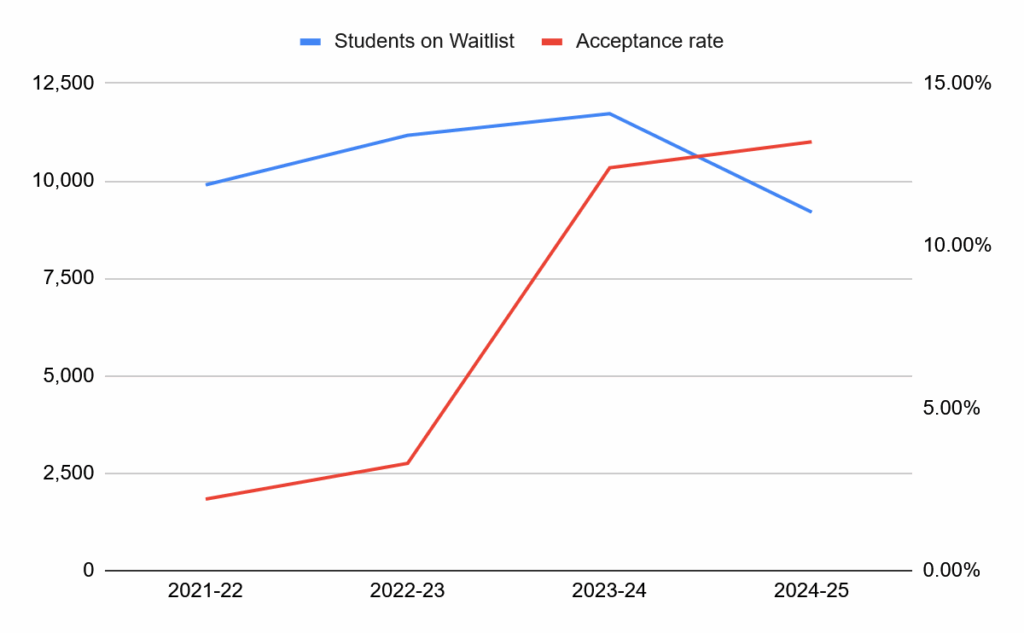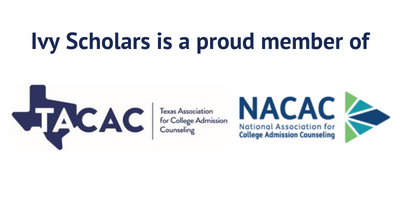You’ve done all the work you were supposed to, written stellar essays, achieved amazing grades, and taken part in astonishing extracurriculars; you send out your applications, and your top school, your number one, puts you on the waitlist. This can feel absolutely crushing, but getting put on a school’s waitlist does not necessarily mean the end of your admissions journey. In this article, we’re going to look at a school where this story is quite common: UCLA. One of the top universities in the country, it is also one of the most popular to apply to. Many students are rejected, but many too are put on the waitlist. In this article, we’re going to examine how UCLA’s waitlist works, why they use it, and how you can maximize your chances of acceptance off the waitlist. Let’s get started!
How UCLA’s Waitlist Works
UCLA does conveniently describe exactly how their waitlist process works, although they may be scanter on the details than many students prefer. Students on the waitlist will begin being admitted after May 1, the waitlist is unranked, and they do not know how many students will get in off the waitlist in a given year.
Looking at the historical data for UCLA’s waitlist clarifies this last point. Thanks to the Common Data Set, we are able to look at how many students have ended up on UCLA’s waitlist, and how many of those have been admitted, over the past several years.
| Year | Students Waitlisted | Students Accepting Place on Waitlist | Students Accepted Off the Waitlist |
| 2024-25 | 15,023 | 9,198 | 1,211 |
| 2023-24 | 18,329 | 11,725 | 1,400 |
| 2022-23 | 16,979 | 11,169 | 367 |
| 2021-22 | 15,242 | 9,897 | 214 |
Looking at this data, it suddenly becomes clear why UCLA states that they can’t give a firm number on how many students will be admitted off the waitlist; this number varies wildly from year to year. To further showcase this point, here is a chart mapping UCLA’s waitlist rate compared to the percentage of those students who end up admitted:

The number of students who accept their spot on the waitlist is relatively consistent; there is some flux, but not a lot of stark changes year to year. The number of students admitted off the waitlist changes significantly more, and more intensely. Thus, there is no good way to determine your odds of acceptance if you are waitlisted at UCLA.
This is because the number of waitlist acceptances isn’t actually in the university’s control; it depends on how many admitted students decide to attend other schools. The more admitted students who choose to go to school elsewhere, the more students who are admitted off the waitlist.
Relatedly, this is why we advise students to withdraw applications once they put in an admissions deposit at a college; it may not be your top school, but it is for someone, and the sooner a school that admitted you knows you won’t be attending, the sooner someone on that school’s waitlist might hear some good news.
What to do if You’re Waitlisted by UCLA
The first thing to do if you are waitlisted is to go to your student portal for UCLA and accept your spot on the waitlist. This is a minor matter of paperwork, but must be done if you want your application to remain under consideration. As you can see in the stats above, many students don’t do this every year.
They do not accept additional application materials from waitlisted students, such as additional letters of recommendation. They do, however, have a palace on the waitlist form to provide any updates or additional information you feel is relevant to your application. This is then reviewed by admissions officers when making waitlist decisions.
While there is a single waitlist pool, we are relatively confident waitlist admissions decisions are made on a per-college basis at UCLA. Applications are reviewed based on which college and major you wish to be part of, and for many majors, there are only so many seats available. Thus, your chances of acceptance are also heavily impacted by which major you are aiming for, though UCLA sadly does not release any kind of granular breakdown of this information.
Thus, the best way to increase your chances of admission off the waitlist is through a well crafted and informative update. While this is not referred to as an update letter, it fulfills the same purpose that many schools have for update letters. To give you a sense of what one of these looks like, and how they operate within an application, we’re going to give you an example from a past Ivy Scholars student, and review what it does well.
UCLA Waitlist Update Example
Dear UCLA Admissions Committee,
Thank you for considering me to be a part of your school! I am excited at the prospect of attending UCLA, and I’d just like to reiterate why it’s my first-choice school and why I think it’s such a great fit for my values and interests.
UCLA’s values of free exchange of knowledge, diversity, and a deep commitment to public engagement all resonate with me. Growing up in Mississippi as a person of color, I felt like a cultural unicorn. I often marveled at how my friends arrived at totally different conclusions during debates regarding a variety of topics, from politics, to literature, to movie reviews. This variety of ideas is only possible when people of different backgrounds come together with open, respectful dialogue. Similarly, I’ve devoted much of my own life to engaging with different paradigms. Teaching creative writing to students with ADHD and autism helped me explore my creative faculties and appreciate multitudes of perspectives. At UCLA, I’m eager to explore the diversity of ideas and viewpoints.
UCLA’s English department appeals to me due to the expertise and experience of the award-winning faculty. Professors Fred D’Aguiar and Justin Torres, in particular, write the kinds of stories I strive to write myself: stories about people on society’s margins, transformed by extreme stress and hope.
I’m looking forward to joining UCLA’s Envelope Magazine and working with my peers at The Writer’s Den. UCLA’s Film and Photography Society will help me celebrate my classmates’ work, and develop my own projects. Since submitting my application, I’ve finished shooting my own short film, which I am now editing and preparing to submit to summer festivals, while maintaining A grades in all my coursework. Revenue from my online comic book company has risen to a steady $1,300/month, confirming the proof of concept and ensuring cashflow for future expansion.
UCLA’s proud declaration of “fiat lux” inspires me. If I could shed light on anything, it would be the extremes of the human condition, through the lens of creative writing, alongside my peers at UCLA. If I am admitted I will immediately accept a place at UCLA.
UCLA Waitlist Update Analysis
The first thing to note is that UCLA has a hard limit on how long these updates can be. Most schools simply allow you to submit a letter by uploading a document, but for UCLA, they have a box on their student portal for you to enter it. There is a cap of 400 words; so you need to choose what you want to say carefully.
The example above has been edited to preserve the student’s anonymity, but you can still see how the author touches on every important aspect of one of these update letters. First, it very briefly reiterates that UCLA is the author’s top choice for a school to attend. Schools want to be sure that if they let you in off the waitlist that you will enroll, and stating this directly is generally the best way to do so.
Next, the author connects their values with those of UCLA. This is a good approach to take if you have fewer new developments to talk about, but still want to highlight some of the things you’ve done, and how they make you a good fit for the school in question. You want to concretely connect everything you mention to the school you are applying to.
The author then provides updates on what they’ve been doing since their initial application was submitted. This is important; colleges only know what you tell them, and the best way to put your application over the edge is by showcasing new achievements, especially major ones. This is indeed the entire purpose of providing this update form.
You should focus on extracurriculars; they will receive your final transcript from your school. Instead, showcase how you have continued to build upon projects you’d already started, or achieved new and interesting things in the time since you applied. These too should ideally be connected with the school and its offerings, showcasing how your current interests and passions dovetail perfectly with the college, making it the logical next step for you.
This is not technically a letter, and doesn’t need to begin by addressing the admissions committee, but a little bit of politeness never hurt.
Final Thoughts
UCLA is an excellent school, and one of the most popular in terms of number of applicants. They have a similarly long waitlist, and admit students off of it each year. We know that getting waitlisted can feel like the end of the world, but it is often just the next step in your admissions journey, another challenge to face. We hope this article has given you insight into how UCLA’s waitlist works, and how you can face it.
Of course, applying to college is never easy; essays to perfect, forms to fill out, deadlines to hit. Waitlists are just another challenge on top of that, more stress and uncertainty. If you’re looking for help dealing with that uncertainty, or crafting your own perfect college application, then Ivy Scholars can help. Our mentors have a long experience aiding students on every aspect of the admissions process, and we’re always happy to hear from you. Schedule a free consultation today to learn more.








